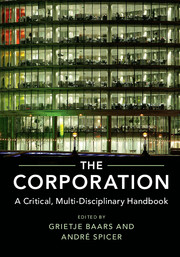Book contents
- Frontmatter
- Contents
- List of Contributors
- Acknowledgements
- Introduction: Why the Corporation?
- PART I DISCIPLINARY OVERVIEWS
- 1 The Corporation in History
- 2 The Corporation in Legal Studies
- 3 The Corporation in Economics
- 4 The Corporation in Sociology
- 5 The Corporation in Anthropology
- 6 The Corporation in Political Science
- 7 The Corporation in Geography
- 8 The Corporation in Accounting
- 9 The Corporation in Management Studies
- PART II INTERDISCIPLINARY THEMATIC CHAPTERS
- 1 The Evolution of the Corporate Form
- 2 The Multinational Corporate Group
- 3 The Financialization of the Corporation
- 4 Corporate Value Chains
- 5 Corporate Citizenship
- 6 The Corporation and Crime
- 7 The Corporation and Ideology
- 8 Corporation and Communities
- 9 Corporations and Resistance
- 10 Alternatives to the Corporation
- Index
- References
7 - The Corporation in Geography
from PART I - DISCIPLINARY OVERVIEWS
Published online by Cambridge University Press: 31 March 2017
- Frontmatter
- Contents
- List of Contributors
- Acknowledgements
- Introduction: Why the Corporation?
- PART I DISCIPLINARY OVERVIEWS
- 1 The Corporation in History
- 2 The Corporation in Legal Studies
- 3 The Corporation in Economics
- 4 The Corporation in Sociology
- 5 The Corporation in Anthropology
- 6 The Corporation in Political Science
- 7 The Corporation in Geography
- 8 The Corporation in Accounting
- 9 The Corporation in Management Studies
- PART II INTERDISCIPLINARY THEMATIC CHAPTERS
- 1 The Evolution of the Corporate Form
- 2 The Multinational Corporate Group
- 3 The Financialization of the Corporation
- 4 Corporate Value Chains
- 5 Corporate Citizenship
- 6 The Corporation and Crime
- 7 The Corporation and Ideology
- 8 Corporation and Communities
- 9 Corporations and Resistance
- 10 Alternatives to the Corporation
- Index
- References
Summary
Introduction
Geographers – or at least more accurately human geographers – have a long history of critical engagement with the firm or corporation in a variety of forms. The discipline itself emerged as a distinct field during the nineteenth century, and its origins are intrinsically entwined with European imperialism and the needs of those states in perpetrating economic and political expansion across the planet (Jones, 2012). In bringing together scientific interest in both the physical and social sciences, geography's holistic approach to understanding the interaction of the natural and social world quickly encompassed the question of the economy of nations, and the major actors within those European imperialist economies – especially the capitalist firm. Human geographical work posed questions of how firms came to develop, why they were located in certain places and what scope there was for them to extend their operations to other regions and countries (see also Faulconbridge, this volume).
In this chapter, I outline the major ways in which contemporary human and economic geography has critically engaged with the idea of the firm or corporation. I take the term ‘critical’ in its broadest of senses, perhaps even beyond the immediate frame of critical social science in a Marxian, (or also Foucauldian) tradition that is often used (ibid.). Geography adopted, I suggest, an inherently interdisciplinary approach, and as well as drawing more explicitly on critical social science, economic geography also poses a theoretically critical cut on understandings of the corporation that have been dominant in some other social science disciplines. Notably, economic geographical work on the corporation has in recent decades been central in challenging some of the relatively simplistic ways in which management or international business scholars have conceptualized and understood corporate globalization (or firm internationalization as it is often also called) (Dicken et al., 2001). I argue therefore that geographers’ contributions to critical understandings of the corporation need to be seen across a range of different types of engagement, not just within a political economic tradition, which, whilst important, represents only one dimension to the subject's contribution.
- Type
- Chapter
- Information
- The CorporationA Critical, Multi-Disciplinary Handbook, pp. 160 - 179Publisher: Cambridge University PressPrint publication year: 2017
References
- 1
- Cited by



